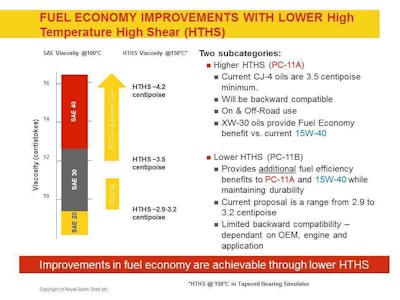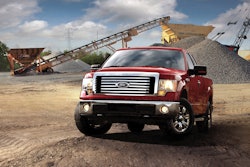
There’s a new heavy-duty diesel oil standard in the works. It will not be available until late next year or early 2017, but the performance requirements for it tell you a lot about where the diesel engine industry is headed.
The industry periodically updates standards to address performance and emissions requirements from OEMs, says Sam Bainbridge, products technical advisor, ExxonMobil. In this case the major focus is on fuel economy, however these oils will also be designed with additional performance features, he says.
New nomenclature
The current heavy-duty diesel engine oil standard is known as CJ-4, as designated by the American Petroleum Institute. The new standard is being called by its working name: PC-11, or Proposed Category 11.
Once licensing begins the oils will probably be designated by the API nomenclature of CK-4 along with a low-viscosity formulation likely to be named FA-4. This is the first time the API has designated a split standard, the difference is largely a matter of the different needs of on-road and off-road diesel engines.
Backwards compatibility
The low-viscosity FA-4 formulations reduce friction in the engine and have the potential to improve fuel economy of on-highway trucks. The FA-4 oils will not be backward compatible with engines older than the 2016-2017 year models, although some manufacturers may allow them for older engines if their tests can show sufficient protection and performance with the low viscosity formulations.
CK-4 oils will be backwards compatible with all trucks and off-road equipment that use the current CJ-4 oils. The off-road engine manufacturers have said they need the high-temperature, high shear (HT/HS) capabilities of the CK-4 formulations to help protect their engines in the high-heat, high-load conditions typical in off-road applications, says Dan Arcy, global OEM technical manager for Shell.
High temp/high shear
Compared to the CK-4 oils the FA-4 oils are formulated with lower HT/HS properties to get improved fuel economy performance in newer model year engines. To help end users better distinguish between API CK-4 and API FA-4 oils, the API is considering an additional designation on the viscosity grades. Oils with low HT/HS may be designated with an “L” at the end of the viscosity nomenclature, says Len Badal, commercial sector manager, Chevron Lubricants. Since the CK-4 oils will have higher HT/HS capabilities they may be designated by an “H” at the end of the designation. For example, the viscosity nomenclature on the new products may read something like: SAE 5W-30L or SAE 10W-30H. Note that like the other nomenclature, the “L” and “H” designations are only being considered at present and have not been finalized.
Fuel efficiency and CO2
Starting in 2017, on-highway trucks will have to meet new fuel efficiency standards. And while none of the lube oil formulators are ready to publish numbers yet, off the record most will tell you that using the new low-viscosity, FA-4 oils will result in about a 1 percent gain in fuel efficiency.
“Burning a gallon of diesel creates 22.38 pounds of CO2. The less fuel you burn the less CO2 you generate,” says Arcy. “We haven’t released our fuel economy numbers for the new low viscosity oils but if you look at our 15W40 vs our 10W30 we see a 1.6 percent fuel economy benefit from the 10W30. So you are going to get an additional environmental and economic benefit from these low-viscosity products,” he says.
Better protection
The new oil formulations will include improvements in oxidation stability, shear stability, wear protection and aeration control, says Bainbridge.
Timing has been advanced in the recent EPA10 model and newer engines that results in engines that run hotter, Badal says. Heat causes oil to break down (oxidation) and increases the potential for sludge build-up, piston and turbocharger deposits so it is imperative that the new oil standard addresses these potential issues to protect engine durability and performance.
“With PC-11 there will be an upgrade in oil performance driven by newer additive technology from current API CJ-4 oils that were launched in 2006,” Badal says.
Lower heavy metal additives a possibility
Oil formulators are also looking at using newer additive chemistry that has lower heavy metals composition and replacing it with a newer generation of additive performance, Badal says. Traditional anti-wear additives found in API CJ-4 products have been around in engine formulations for a very long period of time but they contribute to the ash that accumulates in diesel particulate filters. The new formulations will protect against valve train and engine wear just as well, but may help extend the life and reduce the cleaning required of diesel particulate filters (DPF).
Another benefit of some of these newer PC-11 formulations is that they will have the ability of being used in both diesel and gasoline engines for mixed fleet use. Previous generations of diesel oil formulations were not ideal for use in gasoline engines because of the higher phosphorous levels that can poison gasoline engine catalytic converters, Badal says.
The official licensing date for the new oils is March 2017, but there is discussion about moving that date up a few months. The truck engine manufacturers will have their 2017 models out by the fall of 2016 and would prefer to have the standard approved to be able to meet the requirements set by the EPA regarding fuel economy.












